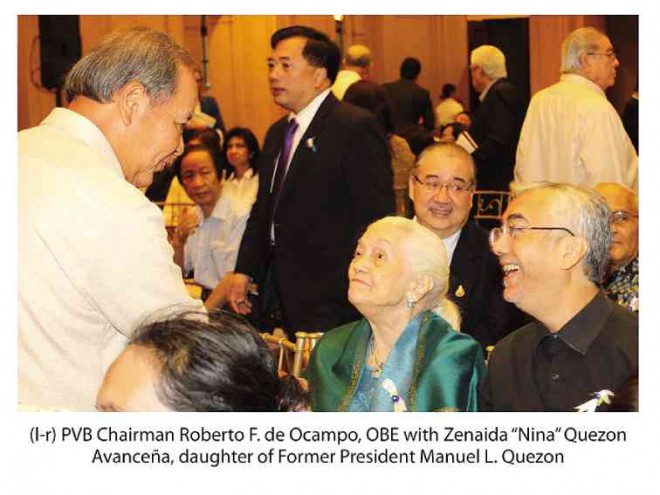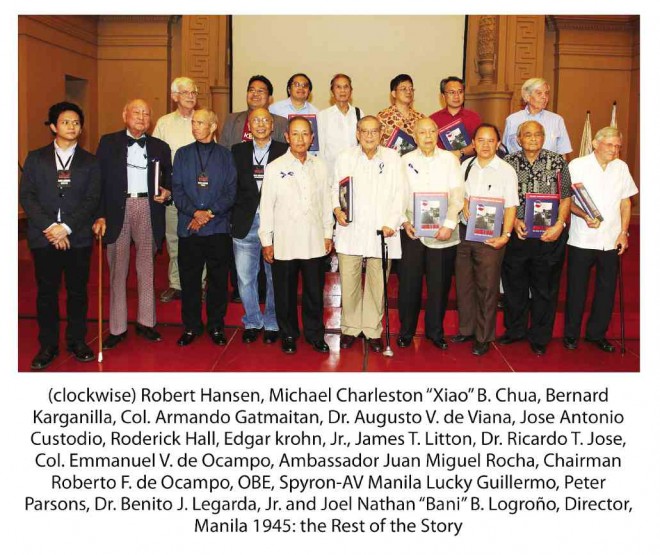Documentary on Battle for Manila is remembrance, reminder
For the people involved in the documentary “Manila 1945: The Rest of the Story” and its companion piece, the special commemorative book of the same title, the projects are as much about remembrance of the past as a reminder to present and future generations.
They particularly want to bring the message to today’s young, hooked on video and computer games, that war is not fun and entertaining. It is vicious, tragic, destructive and deadly.
Produced with the support of the Philippine Veterans Bank (PVB), “Manila 1945: The Rest of the Story” is, as the title suggests, a continuation of a narrative. It is a sequel to an earlier production, “Manila 1945: The Forgotten Atrocities.”
The documentary and book were formally launched to mark the 70th year of the Battle for Manila during World War II (WWII), when Allied Forces came to retake the Philippines from the Japanese invaders.
At the launch at the session hall of the old Legislative Building, which is now part of the National Museum complex, speakers called attention to the unfortunate “collective amnesia” that seemed to afflict today’s Filipinos, seven decades removed from that dark chapter in Philippine history when no one, not even children, was safe from the brutality of an invading force that saw the inevitable end of its control of a prized possession.
Article continues after this advertisementTo “cure” the problem, the film, which had Sylvia Lichauco-de Leon as executive producer and Mai Guillermo as producer, will go on a road show in universities and colleges nationwide.
Article continues after this advertisementFirst stop is the Far Eastern University (FEU), where it will be shown on Feb. 20, 2 p.m. Miguel Villa-Real, PVB vice-president for corporate communications and social affairs, said FEU’s history department was organizing a symposium with filmmakers Peter Parsons and Lucky Guillermo of Spyron-AV Manila as resource persons.
Being arranged is a screening at the De La Salle University Manila after the FEU event.
Historical vacuum
Guillermo, in the Editor’s Note for the book, published by PVB and AV Manila Creative, said, “The question we face today is how this massive atrocity could be so totally erased from a country’s memory. Three generations of Filipinos have grown up in an historical vacuum. Many young people do not accept that Japanese behaved as badly as they did during the occupation of the country, culminating in the frenzied, often gleeful kill-fest of the Battle of Manila.”
Retired Col. Emmanuel V. de Ocampo, PVB chair emeritus and president of the Veterans Federation of the Philippines, in his introduction to the book, lamented “that today’s generation has scant knowledge of what really happened during those four harrowing years from 1941 when war first reached the Philippines until the 1945 liberation. Our school textbooks’ retelling of WWII are now nothing more than figures and dates to be reviewed for tests while the more important lessons of freedom, patriotism and perseverance are now lost [on] or forgotten [by] our youth.”
Roberto de Ocampo, PVB chair, speaking at the formal launch, recalled that the Philippines before the war was considered the Pearl of the Orient.
He stressed the need to let today’s youths know about the past, as he pointed out that the soldiers who fought the Japanese forces were young people like themselves—cadets of the Reserve Officers Training Corps or just ordinary high school students.
In his foreword to the book, Roberto de Ocampo said, “It is time to reintroduce the importance of those days and those men and women to our educational system.”
He said those who read the book should share its message with the young people, the ultimate beneficiaries of the WWII heroes’ courage and sacrifice.
Brian L. Goldbeck, deputy chief of mission of the United States embassy, said during the launch that remembrance of the Philippines’ and US’ shared history should inspire and empower the youth.
Foreign Affairs Assistant Secretary Evelyn Austria-Garcia expressed the hope that the documentary and book would help “wash away” the nation’s collective amnesia and enhance appreciation of Philippine history.
For the youth
Young film director Joel Nathan “Bani” Logroño said “the film was made for the youth, particularly students.”
In both “Manila 1945: The Rest of the Story” and its prequel “Manila 1945: The Forgotten Atrocities,” Parsons and Guillermo zeroed in on the brutality committed by the Japanese military forces on the people of Manila, as the invaders saw their imminent defeat from the advancing military forces led by the American general, Douglas MacArthur.
Like its prequel, the new documentary uses narration, recordings and interviews with survivors, WWII veterans and historians to tell the story of the monthlong Battle for Manila “that saw the Japanese military, then on the cusp of defeat, commit horrific atrocities to the citizens of Manila, leaving about 100,000 non-armed combatants dead.”
Manila sustained great damage to its infrastructure, as allied forces shelled and bombed the city to get the enemy forces to come out of their hiding places.
The film also delves into related aspects of the the war including the Japanese-sponsored Philippine government and Filipino collaboration with the invaders.
Villa-Real said screenings in Manila high schools from February to March, the months when the Battle for Manila was fought, were being arranged with the Department of Education. The film will then be brought to other schools in the National Capital Region and places outside Metro Manila.
As part of the commemoration of the 70th anniversary of the Battle for Manila, the Filipinas Heritage Library (FHL) of the Ayala Museum in Makati City is holding the exhibit “Manila, My City at War!” until March 3.
A mini-conference is being held every Saturday of February at 2 p.m. Speakers include Ricardo Jose, the Philippines’ leading expert on WWII; Gemma Cruz, architect, Inquirer columnist Augusto Villalon, artist Juvenal Sanso and Nick Deocampo.
Students, teachers, librarians, senior citizens and FHL-Ayala Museum members will be charged the discounted rate of P500 each for the lectures. Admission to the exhibit is P150 each for the same groups.
E-mail [email protected] or call (02) 255-8076, (0920) 801-6845 for lecture schedule and reservation.


